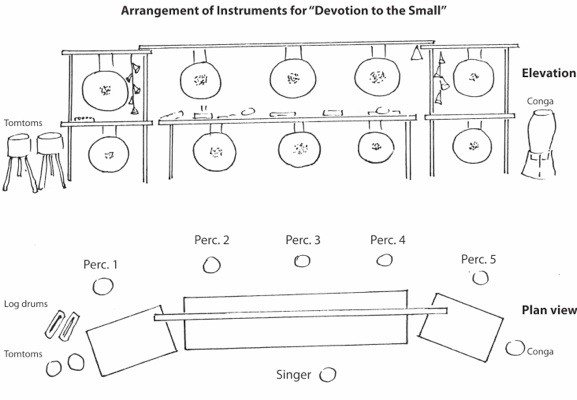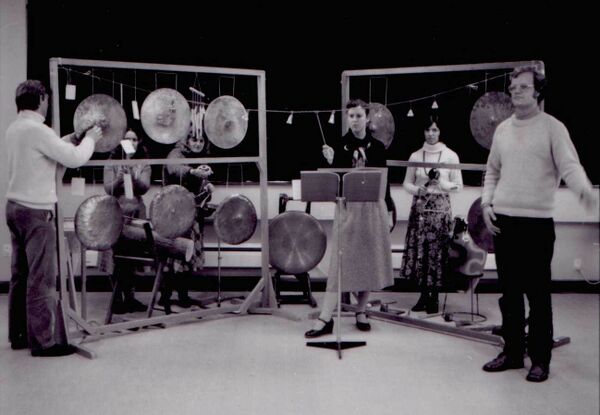Devotion to the Small
General Info
Year: 1980
Duration: c.
Difficulty: (see Ratings for explanation)
Publisher: Waiteata Press
Cost: Score and Parts - $0.00 | Score Only - $0.00
Movements
I. Devotion to the Small
II. Stonepoem
III. Contemplating the Letter O
IV. The Measure
V. 'A Pair of Red Stilts'
Instrumentation
Voice
Player I: Wobble Board, Metal Rods, Stones, Clay Plates, Gongs, Small Bells, Bongos, Log Drums, Bull Roarer
Player II: Bowed Wooden Plate, Sleigh Bells, Stones, Gongs (2), Castanets, Bull Roarer, Log Drums, Guiro
Player III: Thin Plastic Sheet, Bowed Dowel Box, Stones, Clay Chimes, Gongs (2), Vibraslap, Woodblock, Chines Blocks, Sleigh Bells
Player IV: Sheet of Paper, Maraca, Gongs (2), Stones, Bowed Plastic Plate, Bull Roarer, Cow Bell, Strip of Paper
Player V: Coconut Shells, Finger Cymbals, Stones, Gongs (2), Small Bells, Wooden Tom-toms (2-3), Conga, Bull Roarer, Triangle, Claves
Program Notes
"Devotion to the Small” contrasts deliberately with "The Ever-circling Light". There is one solo voice instead of a large choir, and all the large percussion is avoided in favour of small instruments, including many found and home-made instruments. These are arranged on two large stands, so that some of the gongs and bells can also be played by the solo singer, while the rest of the battery is managed by five percussionists. The texts are a selection of six small poems by Michael Harlow, whose themes are also "small".
To a large extent the texts determine the shape of each movement, e.g. the short lines of "Andacht zum Kleinen' are emphasized by breaks in the singer's line. In the second movement "Stone Poem", the text even determines the Instruments: each of the five percussionists has two large stones, which are gradually replaced by the softer sounding clay chimes. In "Contemplating the letter O" ' the singer does just this through a range of emotional Os from sadness, shock, surprise, interest and ecstasy, while the percussionists supply both accompaniment and text. The fourth movement, like the other even-numbered movements, has a strong "tonic", which is superimposed onto the graphic notation. In this movement the singer tries to break away from this tonic, making small jumps at first, but only really succeeding on the very last note. This, note is one of the few big sounds in the whole piece. It is sung fortissimo and supported by two bullroarers, two bowed (Chladne) plates and a vibraslap. This "different" note is an example of the contrast principle on a micro-level which I discussed during the planning period of the piece with poet Michael Harlow: "The lateral leap which throws the whole structure into relief". The fifth movement is an example of the same principle on a macro-level. It stands apart from the other movements by the use of conventional notation and of repetition of various parameters: words, rhythms, even melodic fragments. The number of repetitions of the percussion ostinati and durations of rests were determined by chance, but the number of instruments playing was determined by me. The "lateral leap" in the last movement is given by the percussionists in the form of a brief cadenza. "Devotion to the Small" was recorded in 1980 by Radio New Zealand, with Jillian Bartram singing the solo part. The recording, directed by Dorothy Hitch, was awarded the Mobil prize for the best recorded New Zealand Musical Work in 1981.[1]
Short Program Notes
An experimental setting of six small poems by Michael Harlow for solo soprano and five percussionists. The soprano part uses graphic notation for all but one movement. The percussion parts avoid all the large instruments and also use a number of home-made instruments, e.g. a dowel box (resonating box with dowels of different lengths glued into it, which is played with a violin bow), bowed plate (a wooden version of the Chladni plate) and numerous found gongs. Devotion to the Small was recorded by Radio New Zealand, the recording winning a Mobil Award for best produced New Zealand Musical Work 1981.[2]
Review
The following article was written for CANZONA in the late 1980s (Kit)
Devotion to the Small contrasts deliberately with The Ever-Circling Light. There is one solo voice instead of a large choir, and all the large percussion is avoided in favour of small instruments, including many found and home-made instruments. These are arranged on two large stands, so that some of the gongs and bells can also be played by the solo singer, while the rest of the battery is managed by five percussionists. The texts are a selection of six small poems by Michael Harlow, whose themes are also “small”. To a large extent the texts determine the shape of each movement, e.g. the short lines of Andacht zum Kleinen are emphasized by breaks in the singer's line. In the second movement “Stone Poem”, the text even determines the Instruments: each of the five percussionists has two large stones, which are gradually replaced by the softer sounding clay chimes. In Contemplating the letter O the singer does just this through a range of emotional Os from sadness, shock, surprise, interest and ecstasy, while the percussionists supply both accompaniment and text. The fourth movement, like the other even-numbered movements, has a strong “tonic”, which is superimposed onto the graphic notation. In this movement the singer tries to break away from this tonic, making small jumps at first, but only really succeeding on the very last note. This, note is one of the few big sounds in the whole piece. It is sung fortissimo and supported by two bull roarers, two bowed Chladni plates and a vibraslap. This “different” note is an example of the contrast principle on a micro-level which I discussed during the planning period of the piece with poet Michael Harlow: ‘The lateral leap which throws the whole structure into relief.' The fifth movement is an example of the same principle on a macro-level. It stands apart from the other movements by the use of conventional notation and of repetition of various parameters: words, rhythms, even melodic fragments. The number of repetitions of the percussion ostinati and durations of rests were determined by chance, but the number of instruments playing was determined by me. The “lateral leap” in the last movement is given by the percussionists in the form of a brief cadenza.[3]
Errata
Awards
Commercial Discography
Online Recordings
Recent Performances
To submit a performance please join the TEK Percussion Database
Works for Percussion by this Composer
Concerto for 5 Percussionists and Orchestra - Percussion Quintet, Orchestra
Devotion to the Small - Percussion Quintet, Soprano Voice
The Green Man - Multiple Percussion
Additional Resources
References

